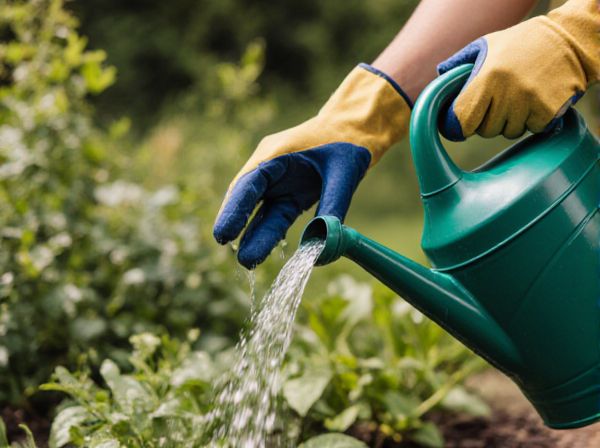
Watering can vs hose wand Illustration
A watering can offers precise control for delicate plants and small garden areas, making it ideal for targeted watering. Hose wands provide greater reach and efficiency for larger gardens, allowing you to water plants without bending or stretching. Choosing between the two depends on garden size and plant sensitivity, ensuring optimal water distribution.
Table of Comparison
| Feature | Watering Can | Hose Wand |
|---|---|---|
| Water Delivery | Manual pouring, controlled flow | Connected to hose, adjustable spray |
| Range | Short, limited by can size | Long, extends hose reach |
| Water Capacity | Usually 1-3 gallons | Unlimited, hose dependent |
| Usage | Small to medium gardens, precise watering | Large gardens, broad coverage |
| Portability | Highly portable, no hose needed | Less portable, requires hose attachment |
| Maintenance | Minimal, rinse after use | Requires hose and nozzle upkeep |
| Cost | Low to moderate | Moderate to high |
Introduction to Watering Tools: Watering Can vs Hose Wand
Watering cans offer precise control for indoor plants and small garden areas, making them ideal for delicate seedlings and container gardening. Hose wands provide extended reach and adjustable spray patterns, efficiently covering larger gardens and reducing strain during watering. Choosing between these tools depends on garden size, plant type, and watering preferences for optimal plant care.
Key Differences Between Watering Cans and Hose Wands
Watering cans provide precise control for delicate plants and small garden areas, offering portability and ease of use without requiring a water source connection. Hose wands, attached to garden hoses, deliver adjustable water pressure suitable for larger spaces and tougher plants, enabling efficient watering with minimal effort. The choice between the two depends on garden size, plant sensitivity, and the need for water flow control.
Ease of Use: Which Tool Offers Better Handling?
Watering cans provide precise control for targeted watering, making them ideal for small gardens and delicate plants, while hose wands offer extended reach and adjustable spray patterns for larger areas. The lightweight design and ergonomic handle of watering cans enhance maneuverability, but hose wands reduce physical strain by allowing users to water without carrying heavy containers. For ease of use, hose wands generally offer better handling in expansive gardens, whereas watering cans excel in situations requiring meticulous watering.
Watering Efficiency: Coverage and Water Delivery Comparison
Watering cans provide targeted, gentle water delivery ideal for small plants and precise watering, minimizing runoff and soil erosion. Hose wands offer broader coverage with adjustable spray patterns, allowing efficient watering of larger garden areas and reducing the time spent on watering tasks. Comparing water efficiency, hose wands typically save water by dispersing moisture evenly, while watering cans enable careful control, making both tools effective depending on garden size and plant needs.
Suitability for Different Garden Sizes and Plant Types
Watering cans are ideal for small gardens and delicate plants, offering precise water control to avoid overwatering. Hose wands suit larger gardens and a variety of plant types by providing adjustable water flow and extended reach, reducing physical strain. Both tools enhance watering efficiency when matched to garden size and plant sensitivity.
Portability and Storage Considerations
Watering cans offer superior portability with lightweight designs and easy maneuverability, making them ideal for small gardens and indoor plants. Hose wands require connection to a hose, limiting mobility but often feature ergonomic grips and wall mounts for convenient storage. Compact storage is simpler with watering cans due to their standalone nature, while hose wands depend on hose length and wall hooks or reels for organized space-saving.
Water Conservation: Which Tool is More Eco-Friendly?
A watering can offers precise water control, reducing waste by delivering water directly to plant roots, making it ideal for conserving water in small gardens or potted plants. Hose wands, while efficient for covering larger areas quickly, often release more water and can lead to overwatering if not carefully managed. For optimal water conservation, using a watering can with measured amounts ensures eco-friendly garden care by minimizing runoff and evaporation.
Maintenance and Durability of Watering Cans vs Hose Wands
Watering cans require minimal maintenance, typically only needing occasional cleaning to prevent algae buildup, enhancing their longevity. Hose wands demand regular inspection for leaks, hose cracks, and joint tightness, with potential replacement parts affecting long-term durability. Quality materials such as galvanized steel or heavy-duty plastic improve the lifespan of both tools, but watering cans generally offer greater durability due to fewer moving parts.
Cost Comparison: Initial Investment and Long-Term Value
A watering can generally requires a lower initial investment, typically ranging from $10 to $30, making it an affordable choice for small gardens and potted plants. In contrast, a hose wand, with prices between $20 and $60, offers greater efficiency and reach, potentially reducing water waste and saving time in larger areas. Over the long term, the hose wand's durability and water-conserving design may provide better value despite a higher upfront cost, while watering cans may incur replacement expenses more frequently due to wear and tear.
Final Recommendations: Choosing the Right Watering Tool for Your Garden
For precise watering in small or delicate garden areas, a watering can offers excellent control and portability, ensuring targeted hydration without soil disruption. Hose wands are ideal for larger gardens, combining extended reach with adjustable spray patterns to cover wide areas efficiently and reduce manual effort. Selecting the right tool depends on garden size, plant type, and watering frequency to optimize plant health and conserve water resources.
Watering can vs hose wand Infographic

 gardendif.com
gardendif.com